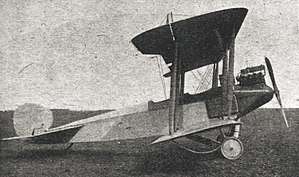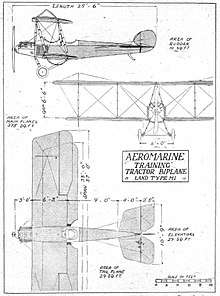Aeromarine M-1
The Aeromarine M-1 was a two-seat training biplane ordered by the US Army's Aviation Section, U.S. Signal Corps (USAAS) in 1917 and built by the Aeromarine Plane and Motor Company of Keyport, New Jersey.
| M-1 | |
|---|---|
 | |
| Role | Trainer |
| National origin | United States |
| Manufacturer | Aeromarine |
| Designer | Charles F. Willard |
| First flight | 1917 |
| Primary user | Aviation Section, U.S. Signal Corps |
| Number built | 6 |
| Variants | Aeromarine 39 |
Design and development
Originally known as Aeromarine Training Tractor, Aeromarine's chief designer, Charles F. Willard,[1] designed a two place trainer in both land-plane and seaplane configuration. The land plane was designated the Aeromarine M-1 and was produced to US Army Specification No.1001.[2] The seaplane version was later called the Aeromarine 39 and sold to the United States Navy (USN). Both aircraft shared much in common, aside from the undercarriage, the primary difference was that the M-1's wingspan was shorter than the Aeromarine 39.
Operational history
Six aircraft were produced and assigned serial numbers 265/270.[3] During Army testing, the aircraft proved to be unsuitable for a training. "Preliminary tests showed that the M1 was unstable in anything but level flight, and most spent the war years packed in their crates."[4]
In 1920, there was a proposal to re-engine these aircraft with the Aeromarine 100hp motor[5]
Specifications (Aeromarine M-1)

General characteristics
- Crew: 2
- Length: 25 ft 6 in (7.77 m)
- Upper wingspan: 37 ft 0 in (11.28 m)
- Lower wingspan: 33 ft 0 in (10.06 m)
- Wing area: 425 sq ft (39.5 m2)
- Airfoil: RAF 6
- Empty weight: 1,200 lb (544 kg)
- Gross weight: 1,900 lb (862 kg)
- Powerplant: 1 × Hall-Scott A-7 4-cylinder water-cooled in-line piston engine, 100 hp (75 kW)
- Propellers: 2-bladed
Performance
- Maximum speed: 78 mph (126 km/h, 68 kn)
- Time to altitude: 10 minutes to 3,500 ft (1,066.80 m)
References
- Reed Business Information Ltd (1917-08-02). Flight International Magazine 1917-08-02.
- Aviation Week (1917-08-15). Aviation Week 1917-08-15.
- "1908-1921 USASC-USAAS Serial Numbers". www.joebaugher.com. Retrieved 2018-03-20.
- C., Fredriksen, John (1999). Warbirds : an illustrated guide to U.S. military aircraft, 1915-2000. Santa Barbara, Calif.: ABC-CLIO. ISBN 1576071316. OCLC 41601136.
- Woodhouse, Henry (1920). Textbook of Applied Aeronautic Engineering. Century Company.
| Wikimedia Commons has media related to Aeromarine M-1. |